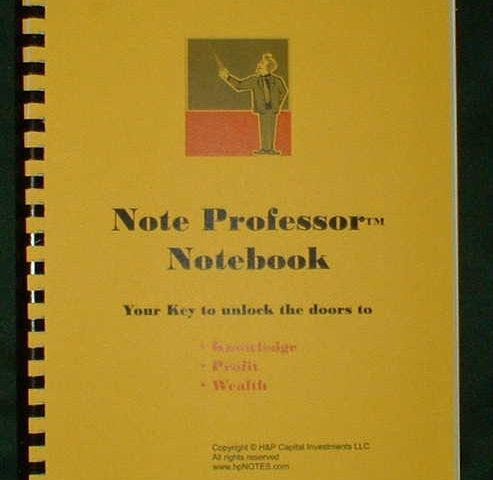Gift WRAPed

How to Get Rich with Notes
July 16, 2021
Advanced Note and Real Estate Concepts In Today’s Market
September 27, 2021Gift WRAPed
by Tom Henderson
From Page 91 of THE NOTE PROFESSOR NOTEBOOK
There are financial advantages to selling properties using a Wrap Note rather than taking back a second lien. There is the safety issue, but here I will discuss only the number crunching. There are “gifts” you can receive when you sell your property utilizing a wrap. Why?scuss only the number crunching. There are “gifts” you can receive when you sell your property utilizing a wrap
A wrap around mortgage, or wrap, for short, is a gift because you will be earning interest on money you do not lend. Great gift, don’t you think? A wrap around mortgage is also called an All Inclusive Trust Deed, and a “Tootsie Pop” mortgage.
A wrap is nothing more than a junior lien that “wraps” around senior liens. In essence, a wrap works like this. The buyers would make you a monthly payment for the wrap note. You then would make the underlying payments, and have a cash flow of what is left. Because your wrap lien includes the underlying senior liens, you will be collecting interest on the spread between your junior lien and the senior liens. Hence, the “all inclusive” term. By collecting interest on money you do not lend, you will greatly increase your yield, as we will later plainly see.
For example, if you had a property worth $100,000 with a mortgage of $70,000 you would have equity of $30,000. Not taking the due on sale clause into consideration, the terms are at 7% with payments of $629.18 for 15 years. Bob and Betty Buyer have offered you $100,000 with 10% down, and want you to finance the rest. You have two options to make this deal work. One is for you to take back a straight secondwith the Buyers assuming the 1st. The other is to take back a wrap around mortgage, where the Buyers would be paying you monthly payments, and you would be paying the underlying lien. Which would offer you the better yield? Lets’ look.
If you structure the deal where the Buyers put their 10% down and assume the 1stlien of $70,000, you would then carry a 2nd of $20,000 dollars @10% interest with payments of $214.92 for 15 years. With this method, you would be receiving a 10% yield. Here is what the note would look like:
N = 180
I/YR= 10
PV = -$20,000
FV = 0
PMT = $214.92
Let’s see what happens if you were to structure this deal using a wrap aroundmortgage. You would be carrying a $90,000 note that would include the senior lien of $70,000, plus the $20,000 you are financing. Your wrap note would look like this:
N = 180
I/YR= 10
PV = -$90,000
PMT = -$967.14
FV = 0
With the $967.14 payment, you would make the underlying payment of $629.18. Subtracting the $629.18 from the $967.14, you will enjoy cash flow of $337.96. By structuring the transaction as a wrap, you have increased your cash flow from $214.92 to $337.96. That is $123.04 more a month!!!
But Tom, how is this possible? Both the 2nd lien note and the wrap were at 10%. The answer is simple. In the first example, you are receiving 10% on only the $20,000 you financed. By using a wrap mortgage, you are not only receiving 10% on the $20,000 that you are financing, but also the spread of 3% (10%-7%) on $70,000, which is money you did not lend. Let me say that again, and in another way, in case you did not pick up on it….YOU ARE RECEIVING 3% ON $70,000 THAT WAS NOT YOUR MONEY!!!
N = 180
I/YR= 19.09
PV = -$20,000
PMT = $337.96
FV = 0
Let’s see what your yield will be: Remember you have $20,000 loaned out, and receiving a cash flow of $337.96 monthly for 180 months. After we identify the variables, we will solve for I/YR. Your deal looks like this:
WOW! You will enjoy a yield of 19.09%, while Bob and Betty Buyer are paying only 10%. Do you understand why I call wraps a gift? There is a gift of an extra 9.09%.
There are several ways to structure wraps. This example is the least complicated, where you had N on underlying liens coinciding with the N on the wrap. You could also have the wrap longer than the underlying, where the underlying lien is paid off at some point, and you keep the entire wrap payment. That can be real fun. You could introduce balloons, graduated payments, or an endless amount of combinations. These combinations can give you even extra gifts.
A wrap note also gives the property seller a little more protection because he/she has full control in paying the underlying lien. This is also another issue that cannot be
addressed in this forum.
Yes, there are disadvantages to wraps, which is also another topic for discussion. In this lesson I wanted to demonstrate how a wrap works, and how you can use a wrap to increase your yield.
This is just another arrow in your “investment quiver”.
As always, obtain competent legal and tax advice when venturing into the world of owner financing, especially wrap around mortgages.


